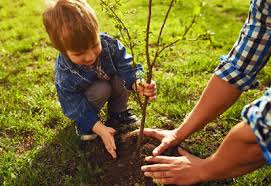Winter Time Mulching; How to Mulch Your Trees and Shrubs to Boost Plant Health & Hardiness
Do you “mulch” your trees and shrubs regularly? Mulching is a tree care activity we often overlook. But it’s more important than many people think. It delivers vital benefits to trees and shrubs that go way beyond making your yard look nice. Put simply, Mulching boosts a plant’s health and hardiness.
So when should you mulch your trees and shrubs? That depends on your goals and the climate in your area. Each season has its pros and cons. The key is knowing when the best time to mulch is for you. Springtime mulching, for example, stimulates root growth but may require re-mulching later on in the season.

Wintertime mulching, on the other hand, insulates roots from sudden cold snaps but can trap frost and damage roots in freezing temperatures. Ultimately, you want to mulch when it’s most beneficial to your trees and shrubs. Soil temperature, rainfall patterns, and tree health are all factors when deciding when to mulch.
Benefits of Mulching
Mulching reduces water evaporation by 30-70%, increases water filtration 3 to 5 times, and lowers soil temperature by as much as 10° F. It also reduces weed pressure by 50-90%, boosts tree growth by 20-50, and deters pests from attacking trees and shrubs. If you use organic materials, it adds vital nutrients to the soil when the material breaks down, enriching the soil and boosting plant growth.
Mulching also:
- Prevents soil compaction from foot traffic and lawnmowers
- Promotes better root penetration and aeration
- Prevents soil erosion from wind and rain
- Protects a tree or a shrub’s base
- Reduces the need to mow or weed around your trees
- Saves maintenance time, cost, and effort.
These benefits can make a difference to your trees and shrubs—no doubt about it. But you need to choose the right mulch to enjoy those benefits. Organic mulch, such as wood chips, tree bark, and shredded leaves, offers advantages inorganic mulch doesn’t offer as discussed above. Inorganic mulch, such as gravel, rubber mulch, and fabric, can suppress weeds effectively but doesn’t deliver organic mulch’s nutrient benefits.
Tips on Mulching
There’s more to mulching than many people think. Here are some tips on how to mulch effectively:
- Mulch when it’s best for your trees and shrubs. Early spring (after the last frost) or late fall are generally ideal because soil temperatures are mild. Avoid mulching when it’s hot and dry, or the ground is frozen.
- Start by removing any weeds or debris around the plant’s base, then identify your drip line—the outermost edge of the plant’s canopy. Spread the mulch to at least this edge but at least three to five feet from the trunk.
- Apply a 2 to 3-inch layer of organic mulch for mature trees and a 1 to 2-inch layer for young and new trees. Leave a gap between 2 to 3 inches from the tree trunk or shrub base. Avoid applying mulch too high. It can choke the choke the roots.
- Create a clean border around the mulch using either bricks, stone, or other edging material, which prevents the mulch from spreading and helps maintain a nice appearance.
- Replenish the mulch layer as it decomposes, or the wind blows it away. The mulch won’t suppress all your weeds, so you may still have to pull some from the ground. Pull them gently to avoid disturbing the mulch. it
- Check the soil under the mulch during dry periods. If it feels dry, water it deeply. You want to make sure the water gets to all the roots.
Apply these tips to mulch in a way that’s designed to boost your tree’s and shrub’s health and hardiness. Also, be mindful of nearby structures and walkways when mulching. It can attract pests.
Also, consider using different types of mulch for different areas of your yard. And don’t use fresh or dyed wood chips. They can release harmful chemicals. Mulching regularly can help your trees and shrubs thrive for years to come.